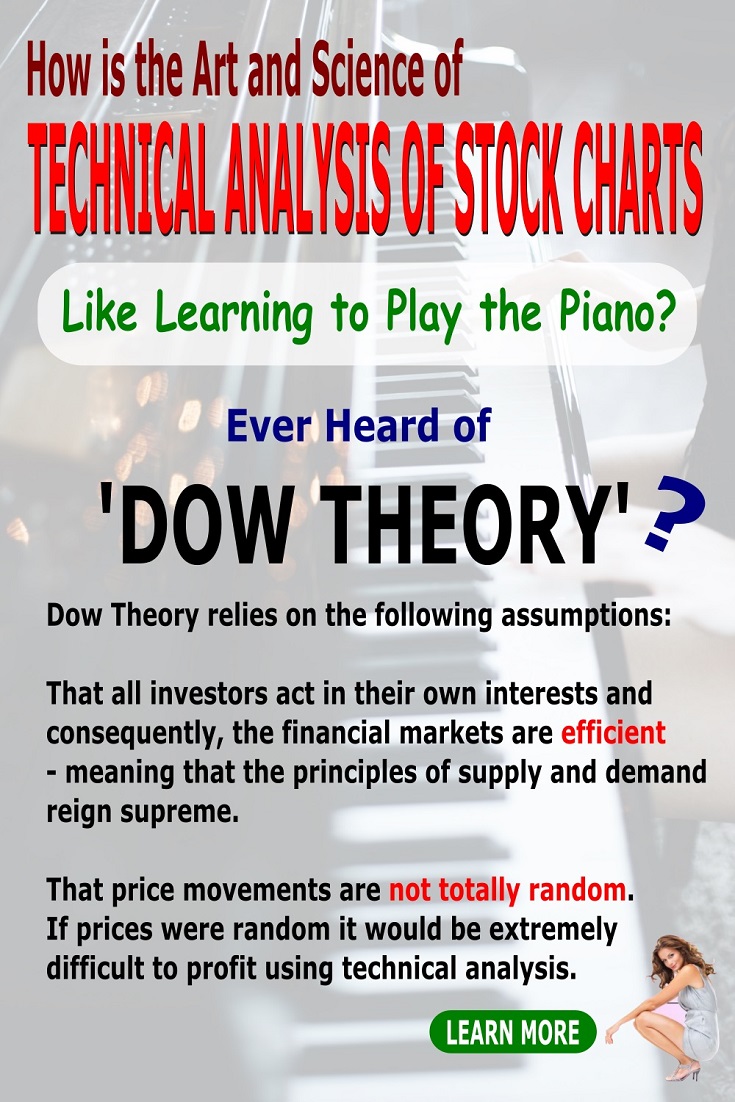Search Options Trading Mastery:
- Home
- Stock Chart Analysis
- Technical Analysis of Stock Charts
Technical Analysis of Stock Charts
The Art and Science Behind Technical Analysis of Stock Charts
Technical analysis of stock charts is both a science and an art.
The science is in identifying all the chart patterns, candlestick formations, trends, channels etc. then adding indicators, bollinger bands and the like, to help determine the strength of a price move, or whether it is likely to consolidate or reverse.
The art is in developing the skill which, through practice, recognizes these things almost instinctively, so that you get an intuitive sense of what is about to happen. It's a bit like learning to play the piano. At first, you learn the theory, but good pianists only 'make it' through many hours of practice.
The idea is to be able to forecast future price movements of a financial instrument and adapt a trading strategy that fits your view.
For longer term investors, technical analysis of stock charts is usually distinguished from fundamental analysis of companies.
While fundamental analysis looks at financial accounting ratios and news events for a particular company, with a view to predicting whether its currently traded share price and dividend payments represent fair value, technical analysts believe that all this information is built into the price charts themselves.
While some technical analysts are longer term traders, most are concerned about short term opportunities. If you're good at technical analysis of stock charts and combine this with a knowledge of options trading together with personal discipline, you can do very well.
Technical Analysis of Stock Charts and Dow Theory
Around the turn of the twentieth century, the basis for modern technical analysis was born. After analysing stock charts over many years, Charles Dow wrote copiously about recurring price patterns and how these can be used to anticipate future moves.
The basis for Dow Theory relies on the following assumptions:
- That all investors act in their own interests and consequently, the financial markets are efficient - meaning that the economic principles of supply and demand reign supreme.
- That price movements are not totally random. If prices were random then it would be extremely difficult to profit using technical analysis.
In his book, "Schwager on Futures: Technical Analysis", Jack Schwager states:
"One way of viewing it is that markets may witness extended periods of random fluctuation, interspersed with shorter periods of non-random behavior. The goal of the chartist is to identify those periods (i.e. major trends)."
Fortunately, using the appropriate option trading strategies, we can profit, not only when a market is trending, but also when it is randomly fluctuating within a price range.
Some of the most useful tools for technical analysis of stock charts are:
- Bollinger Bands - for price volatility.
- Volume of shares traded - tells you a lot about probabilities.
- Trend lines - the trend is your friend, but it's not a friendship that will last forever.
- Stock Chart Patterns - identifying trend reversals and breakouts
- Support and Resistance lines
- Candlestick formations and patterns.
- Indicators - which either confirm our outlook, or warn against possible weakness in it.
Technical analysts consider the market to be 80% psychology and 20% scientific.
Fundamental analysts consider the market to be 20% psychology and 80% scientific.
Psychological or scientific may be open for debate, but there is no questioning the current price action of a security. After all, it is available for all to see and nobody doubts its legitimacy.
The price set by the market reflects the total perception of all participants - and we are not talking about amateurs here. These participants have considered (discounted) everything possible and settled on a price to buy or sell. The forces of supply and demand are at work.
By examining price action to determine which force is prevailing, technical analysis focuses directly on the bottom line: What is the price? Where has it been? Where is it going?
NEXT . . .
UsingTechnical Analysis for Swing Trading Options
Getting the Best Return on Risk
**************** ****************
Return to Stock Chart Analysis Main Page
Go to Option Trading Homepage















New! Comments
Have your say about what you just read! Leave me a comment in the box below.